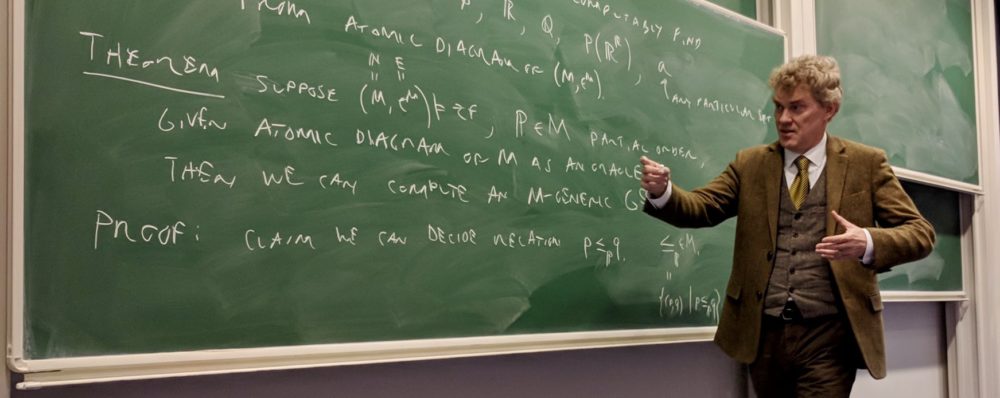I taught a course in Fall 2011 at NYU entitled Topics in Logic: set theory and the philosophy of set theory, aimed at graduate students in philosophy and others who want to gain greater understanding of some of the set-theoretic topics central to work in the philosophy of set theory. The course began with a review of the mathematical ideas, including a presentation of large cardinals, strong axioms of infinity and their associated elementary embeddings of the universe, and forcing, emphasizing the connection with the Boolean ultrapower and Boolean-valued models, but discussing the alternative formalizations. The second part of the course covers some of the philosophical literature, including what it means to accept or believe mathematical axioms, whether mathematics needs new axioms, the criteria one might use when adopting new axioms, and the question of pluralism and categoricity in set theory.
Here is a partial list of our readings:
1. Mathematical background.
2. Penelope Maddy, “Believing the axioms”, in two parts. JSL vols. 52 and 53. Part 1, Part 2
3. Chris Freiling, “Axioms of Symmetry: throwing darts at the real number line,”
JSL, vol. 51. http://www.jstor.org/stable/2273955
4. W. N. Reinhardt, “Remarks on reflection principles, large cardinals, and elementary embeddings,” Proceedings of Symposia in Pure Mathematics, Vol 13, Part II, 1974, pp. 189-205.
5. Donald Martin, “Multiple universes of sets and indeterminate truth values,” Topoi 20, 5–16, 2001.
6. Hartry Field, “Which undecidable mathematical sentences have determinate truth values,” as reprinted in his book Truth and the Absence of Fact, Oxford University Press, 2001.
7. A brief selection from Marc Balaguer, Platonism and Anti-Platonism in Mathematics, Oxford University Press, 1998, describing the plenitudinous Platonism position.
8. Daniel Isaacson, “The reality of mathematics and the case of set theory,” 2007.
9. J. D. Hamkins, “The set-theoretic multiverse,” to appear in the Review of Symbolic Logic.
10. Solomon Feferman, Does mathematics need new axioms? Text of an invited AMS-MAA joint meeting, San Diego, January, 1997.
11. Solomon Feferman, Is the continuum hypothesis a definite mathematical problem? Draft article for the Exploring the Frontiers of Independence lecture series at Harvard University, October, 2011.
12. Peter Koellner, Feferman On the Indefiniteness of CH, a commentary on Feferman’s EFI article.
13. Interpretability of theories, the interpretability degrees and Orey sentences in set theory and arithmetic. Some of the basic material is found in Per Lindström’s book Aspects of Incompleteness, available at http://projecteuclid.org/euclid.lnl/1235416274, particularly chapter 6, and some later chapters.
14. Haim Gaifman, “On ontology and realism in mathematics,” to appear in the Review of Symbolic Logic (special issue connected with the NYU philosophy of mathematics conference 2009).
15. Saharon Shelah, “Logical dreams,” Bulletin of the AMS, 40(20):203–228, 2003. (Pre-publication version available at:http://arxiv.org/abs/math.LO/0211398)
16. For mathematical/philosophical amusement, Philip Welch and Leon Horsten, “The aftermath.”
It’s been a great semester!


